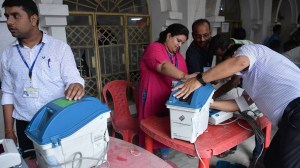- India
- International
Emerging crisis: With rainfall deficit, Kharif sowing falls
However, it’s not only the skewed spatial distribution of rainfall that is to be blamed. The state is going through rainfall deficit as it has received 54 per cent of its average monsoon rainfall so far.
 Women sowing paddy
Women sowing paddy
While the Kharif sowing season is coming to a close, sowing of crops in Gujarat has been done in only 64.50 lakh hectare (lh) so far — a deficit of 25 per cent as compared to average of last three years, and 13 per cent as compared to last year. Government officers, who feel that the sowing acreage is unlikely to see any major upward revision in the days to come, blame the deficit on the skewed spatial distribution of rainfall this monsoon.
However, it’s not only the skewed spatial distribution of rainfall that is to be blamed. The state is going through rainfall deficit as it has received 54 per cent of its average monsoon rainfall so far.
According to the state government data, farmers had sown Kharif crops in 64.50 lakh hectare as of July 30. This is 11.33 lh less as compared to 75.83 lh area farmers had sown during the corresponding period last year — August 8, 2017.
Kutch district, which has highest rainfall deficit at 77 per cent, has the largest sowing deficit too with sowing having been completed in only 23 per cent of land as compared to last year.
In central Gujarat, which comprises eight districts, sowing has been done in 12 lh hectare or about 83 per cent. Of the four high rainfall deficient districts, two — Ahmedabad and Gandhinagar — fall in the region. Six districts of north Gujarat, also experiencing deficient rainfall this monsoon, have recorded sowing in 11.20 lh, which is 89 per cent of the acreage at this time last year.

Interestingly, the south Gujarat region, which has received more than 74 per cent of average monsoon rainfall and has five districts with excess rainfall of 20 to 59 per cent, has also recorded sowing deficit. The Kharif sowing in the seven districts of the region stands at merely 79 per cent as compared to last year. Farmers have sown crops in 5.72 lh as compared to 7.27 lh last year in south Gujarat.
Saurashtra, with the largest cultivable area in the state, has recorded the highest sowing in the state. Farmers in 11 districts of this region have sown crops in 34.45 lh. While it is less than 37.10 lh recorded during corresponding period last year, it still translates to 93 per cent and thus the highest among all the four regions of the state.
Of the 11 districts in the region, five — Porbandar, Devbhoomi-Dwarka, Rajkot, Morbi and Surendranagar — have recorded deficient rainfall, ranging between -20 to -99 per cent, while three — Amreli, Junagadh and Gir-Somnath — have recorded excess rainfall, ranging from +27 per cent to +114 per cent.
So, while Saurashtra as a region has recorded almost 60 per cent rainfall so far, the rainfall has remained concentrated largely in coastal districts. Surendranagar has received only 20 per cent rainfall — a deficit of 62 per cent — while coastal Gir-Somnath has recorded an excess of 114 per cent rainfall.
Incidentally, many districts of the state, including large parts of Saurashtra, had received rainfall in mid-July only, around two weeks late than normal and thus affecting the sowing season. Till the second week of July, sowing was done in merely 45 per cent of normal average area.
“It has rained very little in Maliya and Halvad talukas of Morbi. Maliya doesn’t have irrigation facility except water supplied by Narmada canal. However, they have started releasing water recently and therefore sowing has improved,” Dharamshi Gajera, District Agricultural Officer of Morbi, said.
In Surendranagar district, sowing has been done in 4.46 lh as compared to 5.54 lh last year, and thus registering a drop of around 20 per cent. In Rajkot also, sowing stands at 5.16 lh as compared to 5.35 lh last year. However, districts like Amreli, Junagadh, Gir Somnath, Bhavnagar, Porbandar etc have recorded almost 100 per cent sowing.
“Sowing of almost all crops is over, barring castor and tur (red gram). Farmers sow these crops in the month of August to save them from attack of pests. Therefore, the present figure of acreage may go marginally up. But any big upward revision in the current status is unlikely,” said Mukesh Kasundhra, in-charge joint director of agriculture of Junagadh region.
Despite the deficit in the total sowing area, acreage of cotton and groundnut, the biggest cash crops of the state has almost reached its normal level. The cotton acreage stands at 25.54 lh, which is 98 per cent of average of the last three years and around 97 per cent of last year. Groundnut is marginally down at 14.14 lh or about 94 per cent of its average. “Cotton prices were good last year so groundnut growers have shifted to the fibre crop this year. Some of them have also opted for soya,” Kasundhra further said.
Incidentally, soya is the only crop whose sowing has seen the highest jump. Farmers have sown this oilseed crop in 1.30 lakh hectare, which is 109 per cent of its average. On the other hand, til (sesame seeds) has come down to around 52,000 hectare from 97,000 hectare last year. But the biggest drop has been seen in moong (green gram) and urad (black gram). Their acreage has come down to 38,391 and 4,099 from 1.13 lakh and 24,500, respectively.
Apr 18: Latest News
- 01
- 02
- 03
- 04
- 05






































